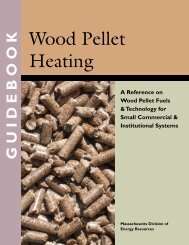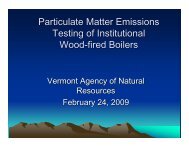Wood-Chip Heating Systems - Biomass Energy Resource Center
Wood-Chip Heating Systems - Biomass Energy Resource Center
Wood-Chip Heating Systems - Biomass Energy Resource Center
You also want an ePaper? Increase the reach of your titles
YUMPU automatically turns print PDFs into web optimized ePapers that Google loves.
Older Residential Stove 1<br />
EPA Certifi ed Stove 2<br />
Particulate Matter from Various <strong>Wood</strong> Combustion <strong>Systems</strong><br />
Pellet Stove 3<br />
Industrial <strong>Wood</strong> Boilers 4<br />
School-sized Boilers 5<br />
McNeil Generating Plant 6<br />
.005<br />
1 Calculations by <strong>Biomass</strong> <strong>Energy</strong> <strong>Resource</strong> <strong>Center</strong>, based<br />
on EPA AP-42 data for a mix of pre-certifi cation and<br />
post-certifi cation residential wood stoves and on<br />
school wood energy systems characterized in note 2.5<br />
(below).<br />
2,3 U.S. Environmental Protection Agency. Compilation<br />
of Air Pollutant Emission Factors, AP-42, Fifth Edition,<br />
Volume I: Stationary Point and Area Sources: External<br />
Combustion Sources, Residential <strong>Wood</strong>s Stoves:<br />
Final Section; Table 1-10.1: Pre-Phase I Non-Catalytic<br />
(SCC 21-04-008-050), Phase II Non-Catalytic (SCC<br />
21-04-008-050), Pellet Stove Type (Certifi ed) (SCC 21-<br />
04-008-053), (PM10) at 5100 BTU/lb (dry wood value)<br />
and 40% moisture content.<br />
4 U.S. Environmental Protection Agency. Compilation of<br />
Air Pollutant Emission Factors, AP-42, Fifth Edition,<br />
a child attending a wood-heated school is negligible<br />
compared to the risk of living in a home where a wood<br />
stove is in regular use. Children are also at much<br />
greater risk from particulate matter in the exhaust of<br />
idling school buses than from wood heating plant<br />
emissions.<br />
CLIMATE CHANGE<br />
The greatest environmental benefi t of burning<br />
wood for energy is in its positive impact in moderating<br />
climate change. CO2 buildup in the atmosphere is<br />
the primary cause of global climate change. Fossil<br />
fuel combustion takes carbon that was locked away<br />
underground (as crude oil and gas) and puts it in the<br />
atmosphere as CO2. When wood is burned, however, it<br />
recycles carbon that was already in the natural carbon<br />
cycle. The net effect of burning wood fuel is that no<br />
new CO2 is added to the atmosphere, as long as the<br />
forests from which the wood came are sustainably<br />
managed. Therefore, when wood replaces fossil<br />
0 0.5 1.0 1.5 2.0 2.5<br />
3.0<br />
Lbs/million Btu Input<br />
Volume I: Stationary Point and Area Sources: External<br />
Combustion Sources, <strong>Wood</strong> Residue Combustion<br />
Boilers: Final Section; Table 1.6-1: Bark and Wet <strong>Wood</strong><br />
Mechanical Collector, Filterable PM 10.<br />
5 Holzman, Michael I. Richard S. Atkins, Leigh A.<br />
Gammie. 1996. <strong>Wood</strong>-<strong>Chip</strong> Fired Furnaces Testing Project<br />
Air Emissions Testing and Public Health Impacts Analysis.<br />
Coalition of Northeastern Governors, Washington D.C.<br />
13-14 pp. Average of all tests (PM10).<br />
6 Clean Air Engineering PM Tests (EPA standard) of the<br />
Joseph C. McNeil Generating Station, Burlington,<br />
Vermont, 1988. (Average of test results)<br />
Note: The values in the graph represent uncontrolled stoves and<br />
controlled boilers/power plant. This represents the situations<br />
most often found in the fi eld.<br />
fuel, the net impact is to reduce CO2 levels in the<br />
atmosphere signifi cantly.<br />
For a school district or other public building owner<br />
interested in meaningfully addressing climate change<br />
and renewable energy through its energy use, heating<br />
with wood is a powerful tool. Making the building<br />
itself more effi cient is always an excellent strategy for<br />
addressing fuel consumption and CO2 emissions.<br />
This approach may reduce heating fuel use (oil or gas)<br />
and related CO2 emissions by 10-20 percent. However,<br />
if the heating system is converted to wood fuel, CO2<br />
emissions are reduced by 75-90 percent.<br />
OTHER EMISSIONS<br />
Oxides of sulfur (SOx) cause acid rain. Modern<br />
wood systems have one sixth the SO2 emissions of fuel<br />
oil. Oxides of nitrogen (NOx) cause ozone, smog, and<br />
respiratory problems. <strong>Wood</strong> and fuel oil combustion<br />
have similar levels of NOx emissions.<br />
All fuel combustion processes produce carbon<br />
WOOD CHIP HEATING SYSTEMS<br />
35





